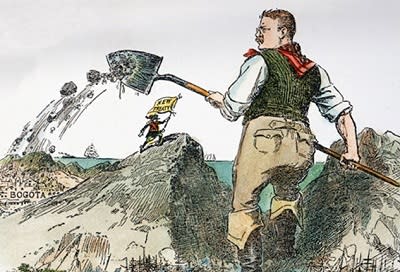After 102 years, the Panama Canal still symbolizes executive power
As the Panama Canal celebrates its 102nd birthday today, the bold act of one U.S. President still resonates as a stroke of policy genius or a grand expansion of executive power.
On August 15, 1914, the Panama Canal officially opened for business, during the administration of President Woodrow Wilson. But it was Wilson’s archrival who was the driving force behind the canal.
In 1911, former President Theodore Roosevelt told an audience in Berkeley, California, that he had decided as chief executive to ensure access to the isthmus of Panama, then part of the nation of Colombia, in order to get a canal built as the centerpiece of America’s growing global power.
“The Panama Canal would not have been started if I had not taken hold of it, because if I had followed the traditional or conservative method I should have submitted an admirable state paper occupying a couple of hundred pages detailing all of the facts to Congress and asking Congress’ consideration of it,” he said.
“In that case there would have been a number of excellent speeches made on the subject in Congress; the debate would be proceeding at this moment with great spirit and the beginning of work on the canal would be 50 years in the future. Fortunately the crisis came at a period when I could act unhampered. Accordingly, I took the Isthmus, started the canal and then left Congress not to debate the canal, but to debate me.”
Roosevelt firmly believed in the “stewardship” theory of the presidency, which held that “executive power was limited only by specific restrictions and prohibitions appearing in the Constitution or imposed by the Congress under its constitutional powers.”
In his first State of the Union address in 1902, President Roosevelt made it clear that the canal was a top priority for his administration.
“No single great material work which remains to be undertaken on this continent is of such consequence to the American people as the building of a canal across the Isthmus connecting North and South America,” he told Congress. “It is emphatically a work which it is for the interest of the entire country to begin and complete as soon as possible; it is one of those great works which only a great nation can undertake with prospects of success, and which when done are not only permanent assets in the nation’s material interests, but standing monuments to its constructive ability.”
In 1903, the United States supported a bloodless revolution in the Colombian province of Panama after the Colombian government rejected a U.S. treaty to acquire land in Panama to build the canal. The United States Senate offered $10 million for the land; the Colombian government wanted $25 million.
As the Colombian government sent troops to put down the rebellion, a U.S. warship, the Nashville, appeared with a contingent of Marines off the Panamanian coast, along with other U.S. naval vessels. The next day, Panama declared independence and Roosevelt quickly recognized Panama as a Republic and offered it protection.
Philippe Bunau-Varilla, a French citizen, acted as Panama’s agent and negotiated a new canal treaty with Secretary of State John Hay, which was ratified by the Senate in February 1904. The United States government gave the $10 million offered to Colombia to the Panamanians as part of a new treaty. It also supplied a constitution to Panama that gave the American government the right to “intervene in any part of Panama, to reestablish public peace and constitutional order.”
The President’s actions didn’t go unopposed back home, with some calling it “an act of sordid conquest.” But the United States started its Panama Canal project that year. The 10-year endeavor cost $375 million and 5,609 lives, and to many it became the new symbol of American imperial power.
Colombia didn’t recognize Panama as a republic until 1921, when the U.S. Senate signed the Thomson-Urrutia Treaty. The pact had been signed in 1914 and ratified by the Colombian government, but the U.S. Senate refused to ratify the treaty at first, as Roosevelt’s supporters saw it as an insult to the former President.
The treaty ratified in 1921 deleted a paragraph from 1914 where Congress expressed “severe regret” to the Colombian government for Roosevelt’s actions. The final treaty terms gave Colombia free access to the canal to transport certain goods and services, and a payment of $25 million in gold to Colombia.
More Constitution Daily History Stories
50 interesting facts about Abraham Lincoln’s life


